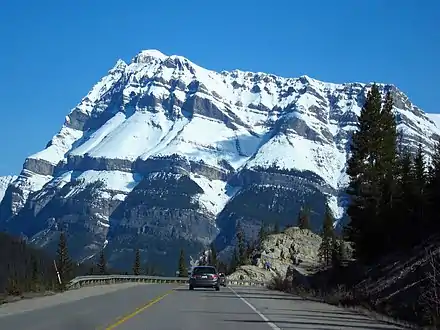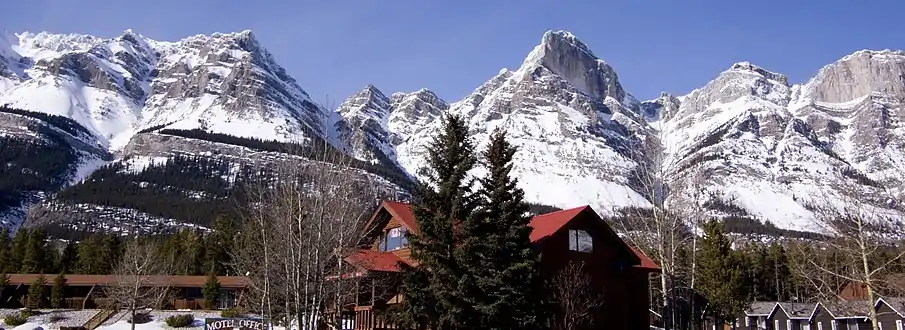Mount Wilson (Alberta)
Mount Wilson is a 3,260-metre (10,696 ft) mountain summit located in the North Saskatchewan River valley of Banff National Park, in the Canadian Rockies of Alberta, Canada. Its nearest higher peak is Mount Cline, 9.81 km (6.10 mi) to the northeast.[3] Mount Wilson is situated immediately north of the confluence of the North Saskatchewan River, Mistaya River, and Howse River near Saskatchewan Crossing, where the Icefields Parkway intersects with the David Thompson Highway.
| Mount Wilson | |
|---|---|
 Mount Wilson and Wilson Icefield seen from the David Thompson Highway | |
| Highest point | |
| Elevation | 3,260 m (10,700 ft)[1] |
| Prominence | 780 m (2,560 ft)[1] |
| Parent peak | Mount Cline (3361 m)[1] |
| Listing | Mountains of Alberta |
| Coordinates | 52°01′04″N 116°48′04″W[2] |
| Geography | |
 Mount Wilson Location of Mount Wilson in Alberta  Mount Wilson Mount Wilson (Canada) | |
| Country | Canada |
| Province | Alberta |
| Parent range | Cline Range Canadian Rockies |
| Topo map | NTS 83C2 Cline River[2] |
| Geology | |
| Type of rock | Sedimentary |
| Climbing | |
| First ascent | 1902 by Outram and Kaufmann[1] |
| Easiest route | technical climb |
History
Mount Wilson honours Tom Wilson (1859–1933) who was an early explorer in the Canadian Rockies. The mountain was named in 1898 by Norman Collie.[2] The first ascent of the mountain was made in 1902 by James Outram and Christian Kaufmann.[1] The mountain's name was officially adopted in 1924 by the Geographical Names Board of Canada.[2]
Geology
Like other mountains in Banff Park, Mount Wilson is composed of sedimentary rock laid down from the Precambrian to Jurassic periods.[4] Formed in shallow seas, this sedimentary rock was pushed east and over the top of younger rock during the Laramide orogeny.[5] The west and south aspects of the mountain are characterized by rugged, rocky cliff bands, whereas the north and east aspects of Mount Wilson are covered by expansive glacial ice called the Wilson Icefield.
Climate
Based on the Köppen climate classification, Mount Wilson is located in a subarctic climate zone with cold, snowy winters, and mild summers.[6] Temperatures can drop below −20 °C (−4 °F) with wind chill factors below −30 °C (−22 °F). Weather conditions during winter make Mount Wilson one of the premier places in the Rockies for ice climbing. Precipitation runoff from Mount Wilson drains into tributaries of the Saskatchewan River.
Ice Climbing Routes
Ice Climbing Routes with grades on Mount Wilson:
Gallery
 Mt. Wilson from northbound Icefields Parkway
Mt. Wilson from northbound Icefields Parkway Mount Wilson
Mount Wilson Mount Wilson's lower cliffs seen from Saskatchewan Crossing
Mount Wilson's lower cliffs seen from Saskatchewan Crossing
References
- "Mount Wilson". Bivouac.com. Retrieved 2018-10-14.
- "Mount Wilson". Geographical Names Data Base. Natural Resources Canada. Retrieved 2018-10-14.
- "Mount Wilson, Alberta". Peakbagger.com.
- Belyea, Helen R. (1960). The Story of the Mountains in Banff National Park (PDF). parkscanadahistory.com (Report). Ottawa: Geological Survey of Canada. Archived (PDF) from the original on 2015-10-02. Retrieved 2019-09-13.
- Gadd, Ben (2008). Geology of the Rocky Mountains and Columbias.
- Peel, M. C.; Finlayson, B. L.; McMahon, T. A. (2007). "Updated world map of the Köppen−Geiger climate classification". Hydrol. Earth Syst. Sci. 11: 1633–1644. ISSN 1027-5606.
- Mount Wilson Archived 2018-10-15 at the Wayback MachineMountain Project
- "Mount Wilson". SummitPost.org. Retrieved 2018-10-14.
External links
- Parks Canada web site: Banff National Park
- Mount Wilson weather: Mountain Forecast